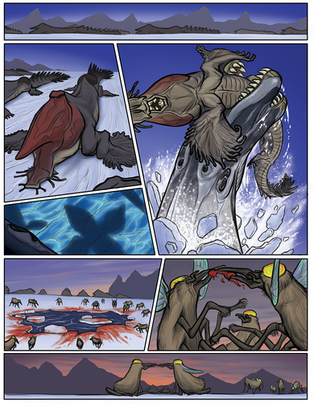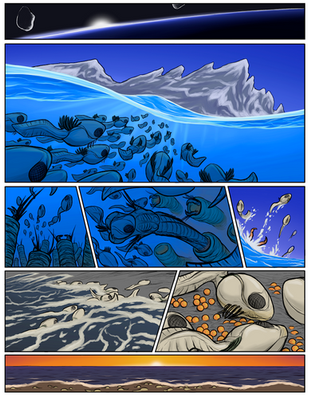HOME | DD
 Transapient — Gachuwits: request by jorre1
Transapient — Gachuwits: request by jorre1

Published: 2014-02-06 19:28:01 +0000 UTC; Views: 7670; Favourites: 108; Downloads: 20
Redirect to original
Description
Hey there, this is a request by jorre1 for some sort of “hive creature”. I hope it is satisfactory.
Gachuwits: The planet Delougod supports a thriving biosphere which has been progressing for several billion years now. Among its more complex inhabitants are the gachuwits, native to the seasonal climates of the southeastern section of the world’s single supercontinent. The “vertebrate” analogs of this world exhibit an extreme form of sexual dimorphism. Almost all large body forms are males, while females exist as relatively tiny, worm-like creatures which thrive in numbers and densities similar to Earth’s nematode worms. The family that includes the gachuwits is known for having developed a social system similar to ants. Females gather in masses to create a “hive nest”, which the males take to guarding and providing for. There are two basic types of males; a worker class with narrow beaks for nimble work in construction and care for the nest, and a soldier class with stronger bodies and heavily serrated beaks for defending and attacking. Like other vertebrates of Delougod, they are tripedal, possess several ganglion-brains, and sense their cloudy, dim world mostly through a super sense of smell with their antennae. New males of the same colony are gestated within the underground network of the nest, being brought to the surface birthing pods once they are ready. The females encased within the network will accept sperm from rarely produced kings, which are much smaller than the other male casts. The kings live only to deliver sperm to the females in other nests, which will be stored to supply the colony with plenty of new males.
Related content
Comments: 13

I'm happy you like it.
-----
"Evolve and Grow." -- The Universe
👍: 0 ⏩: 0


👍: 0 ⏩: 1

The males simply insert their sperm into the hive nest, where only the few specialized fertile females gather up the sperm to become wombs for the new babies.
-----
"Evolve and Grow." -- The Universe
👍: 0 ⏩: 1

Thank you.
-----
"Evolve and Grow." -- The Universe
👍: 0 ⏩: 0

Thanks.
-----
"Evolve and Grow." -- The Universe
👍: 0 ⏩: 0

Actually, relatively few females are fertile out of the whole nest. Those that are will become, basically wombs in the underground sections to grow new sons. The females themselves, unless fertilized by a king, multiply themselves through splitting or parthenogenesis.
-----
"Evolve and Grow." -- The Universe
👍: 0 ⏩: 1

Cool, I like the splitting/parthenogenesis bit.
How do females travel around the nest? If I'm not mistaken, it looks like their "legs" are tentacles? Which doesn't seem like a good way to get around. And how do the baby males get enough nutrients (I assume the females do this job, but I'm not really sure how that would work)? Do they mature completely before they hatch, or only up to a certain point?
👍: 0 ⏩: 1

The females move around with the "tentacles" acting more like worms' body segments, pulling and sliding themselves along through mucus-lined tunnels. Developing male offspring are gestated in specialized composite chambers that become more like wombs until they are around a fourth the size of the adults. They are sustained by nutrients delivered by females underground, as well as males burying captured prey for the females to break down.
-----
"Evolve and Grow." -- the Universe
👍: 0 ⏩: 0


























